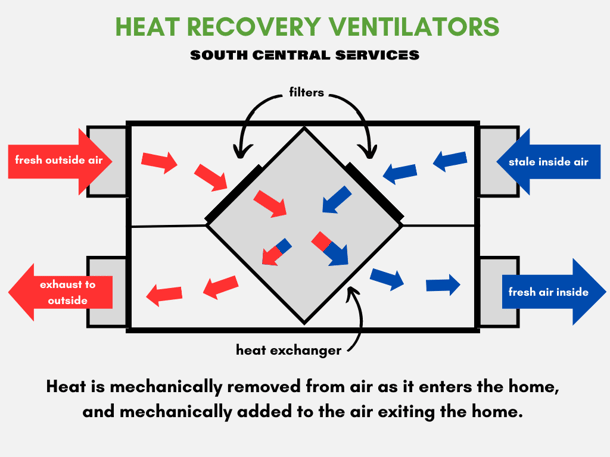The All-Inclusive Guide to the Uses of Heat Recovery Ventilation in Modern Buildings
Heat Recovery Ventilation (HRV) systems stand for a considerable innovation in developing modern technology (HRV Heat Recovery Ventilation). They give a technique for exchanging stagnant indoor air with fresh outdoor air while minimizing power loss. This method not only improves indoor air high quality but likewise adds to energy performance in both domestic and business structures. Understanding the different applications and advantages of HRV can reveal its critical function in modern-day design and sustainability initiatives. The implications of this modern technology are worth discovering additionally
Understanding Heat Recovery Ventilation Solutions

Although many contemporary structures focus on energy performance, recognizing warm recovery ventilation (HRV) systems is essential for maximizing interior air top quality and decreasing power intake. HRV systems function by moving warmth from stagnant indoor air to inbound fresh air, effectively maintaining comfortable indoor temperatures while minimizing energy loss. These systems include a warmth exchanger, followers, and ductwork that promote the circulation of air. During wintertime, HRV systems catch and reuse heat from the outgoing air, while in summer season, they can assist cool down inbound air. By constantly exchanging air, HRV systems likewise lower humidity and the concentration of interior contaminants. Proper setup and upkeep of HRV systems are vital for their performance and effectiveness in boosting overall building performance and comfort.
Benefits of Heat Recovery Ventilation
Heat recovery ventilation systems offer numerous benefits that boost both power effectiveness and interior air top quality in contemporary buildings. By capturing and reusing power from exhaust air, these systems significantly lower heating and cooling expenses, resulting in lower power consumption. In addition, they preserve a consistent circulation of fresh exterior air, reducing the threat of interior air contaminants and irritants. This continual exchange aids regulate moisture levels, avoiding mold development and making sure a much healthier living setting. In addition, HRV systems add to sustainability goals by reducing overall carbon footprints. Their capacity to optimize air flow without sacrificing thermal comfort makes them a beneficial addition to modern structure design, advertising both financial and ecological advantages.
Applications of HRV in Residential Structures
As homeowners increasingly focus on power effectiveness and interior air high quality, the applications of warmth recovery ventilation (HRV) systems in property structures have ended up being much more common. HRV systems are particularly useful in snugly secured homes, where maintaining fresh air flow is crucial for preventing moisture accumulation and interior toxins. They properly transfer heat from outgoing stale air to incoming fresh air, decreasing energy expenses connected with cooling and heating. Additionally, HRVs can enhance comfort degrees by managing moisture and temperature level. They are additionally versatile for numerous residential designs, including single-family homes and multi-unit buildings. Overall, integrating HRV systems sustains lasting living methods while making sure a much healthier interior atmosphere for passengers.
HRV in Industrial and Industrial Settings
In commercial and commercial settings, the execution of warm recovery air flow (HRV) systems has come to be significantly essential for optimizing energy effectiveness and preserving air high quality. These systems successfully move over at this website warm from exhaust air to incoming fresh air, decreasing the need for additional heating or air conditioning. This not just decreases power expenses but also contributes to sustainability campaigns. Industries such as production, warehousing, and office complex profit substantially from HRV systems, as they assist manage temperature level and moisture degrees, making certain a comfortable and effective environment. HRV systems aid in removing contaminants and excess moisture, boosting interior air quality. As laws around air top quality become more stringent, the adoption of HRV innovation is likely to expand, making it an important component of contemporary commercial and commercial infrastructure.
Future Trends in Heat Recovery Ventilation Modern Technology

Frequently Asked Concerns
Just How Does Heat Recovery Ventilation Effect Indoor Air Top Quality?
Heat recovery ventilation substantially improves indoor air quality by continuously exchanging stale interior air with fresh exterior air while recouping power. This procedure reduces contaminants, maintains ideal moisture degrees, and ensures a healthier environment for residents.
Can HRV Systems Be Set Up in Existing Structures?
HRV systems can undoubtedly be installed in existing buildings. Retrofitting might need alterations to ductwork and air flow layouts, but it substantially enhances energy effectiveness and interior air top quality, making it a viable option for older frameworks.
What Maintenance Is Needed for HRV Solutions?

Exist Specific Climates Where HRV Is More Effective?
Heat recovery ventilation systems are specifically efficient in environments with considerable temperature distinctions between periods. These systems enhance energy performance by recuperating heat from exhaust air, making them perfect for both cold and moderately cozy settings.
Exactly How Do HRV Systems Affect Power Bills?
